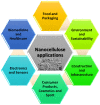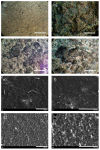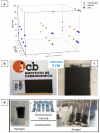3D-Printable Nanocellulose-Based Functional Materials: Fundamentals and Applications
- PMID: 34578674
- PMCID: PMC8471614
- DOI: 10.3390/nano11092358
3D-Printable Nanocellulose-Based Functional Materials: Fundamentals and Applications
Abstract
Nanomaterials obtained from sustainable and natural sources have seen tremendous growth in recent times due to increasing interest in utilizing readily and widely available resources. Nanocellulose materials extracted from renewable biomasses hold great promise for increasing the sustainability of conventional materials in various applications owing to their biocompatibility, mechanical properties, ease of functionalization, and high abundance. Nanocellulose can be used to reinforce mechanical strength, impart antimicrobial activity, provide lighter, biodegradable, and more robust materials for packaging, and produce photochromic and electrochromic devices. While the fabrication and properties of nanocellulose are generally well established, their implementation in novel products and applications requires surface modification, assembly, and manufacturability to enable rapid tooling and scalable production. Additive manufacturing techniques such as 3D printing can improve functionality and enhance the ability to customize products while reducing fabrication time and wastage of materials. This review article provides an overview of nanocellulose as a sustainable material, covering the different properties, preparation methods, printability and strategies to functionalize nanocellulose into 3D-printed constructs. The applications of 3D-printed nanocellulose composites in food, environmental, and energy devices are outlined, and an overview of challenges and opportunities is provided.
Keywords: 3D printing; additive manufacturing; composites; nanocellulose; packaging; sustainable materials.
Conflict of interest statement
The authors declare no conflict of interest.
Figures















References
-
- Aitomaki Y., Oksman K. Reinforcing efficiency of nanocellulose in polymers. React. Funct. Polym. 2014;85:151–156. doi: 10.1016/j.reactfunctpolym.2014.08.010. - DOI
-
- Oksman K., Aitomaki Y., Mathew A.P., Siqueira G., Zhou Q., Butylina S., Tanpichai S., Zhou X.J., Hooshmand S. Review of the recent developments in cellulose nanocomposite processing. Compos. Part A Appl. Sci. 2016;83:2–18. doi: 10.1016/j.compositesa.2015.10.041. - DOI
Publication types
LinkOut - more resources
Full Text Sources
Other Literature Sources

